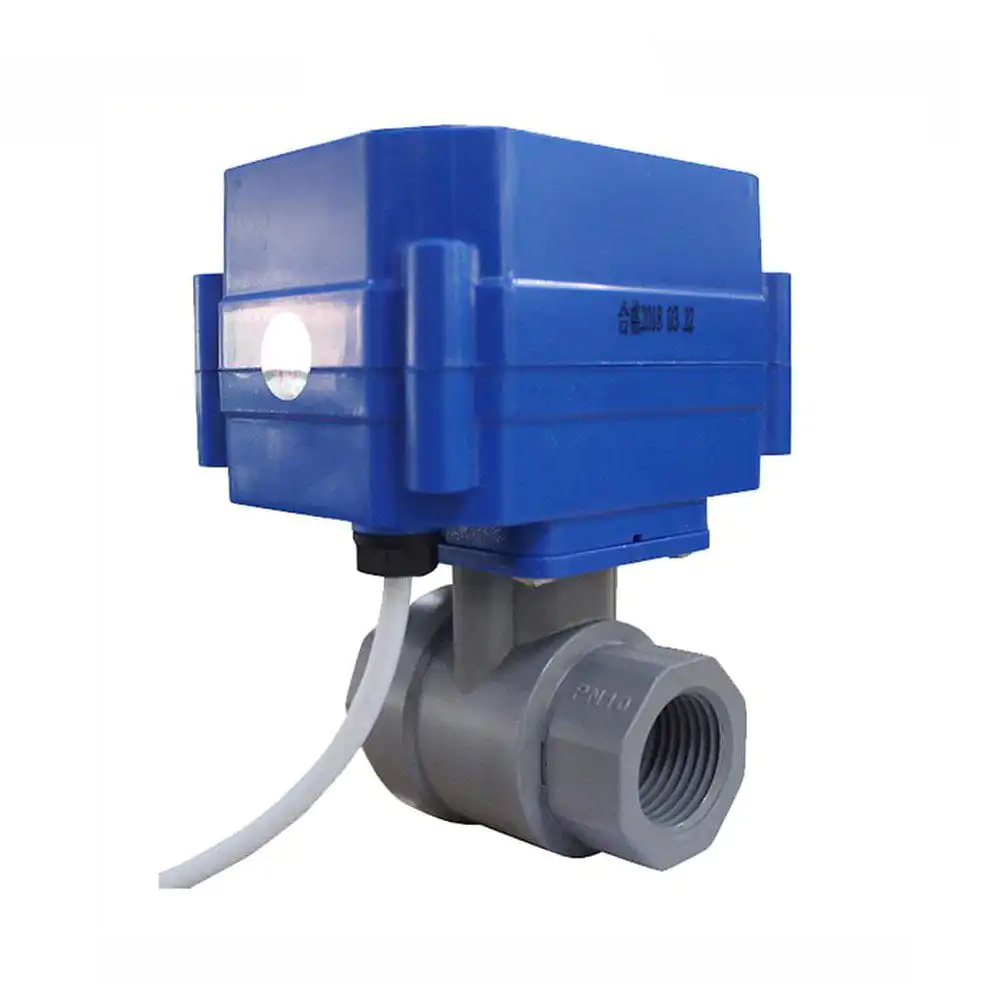COVNA Products

COVNA HK62-P 2 Way 3/4” UPVC Motorized Ball Valve
The COVNA Miniature Motorized Ball Valve is crafted from high-quality materials including PVC, UPVC, brass, and stainless steel, and operates on AC110V–230V or DC9–24V. Available in sizes from 1/2″ to 2″, it features zero leakage, excellent sealing, and an open/close response under 5 seconds. This valve is ideal for various industrial applications such as HVAC, firefighting, water treatment, pipeline purging, analytical instruments, and flue gas sampling.
- Model: HK62-P
- Size Range: 1/2" to 3/4"
- Pressure Range: 0~1.0MPa
- Material: UPVC, Stainless Steel or brass
Technical Parameters of Valve Body
|
Model
|
HK62-P
|
Voltage
|
AC110V~230V, DC9~24V |
|
MOQ
|
1 Set
|
Working current
|
≤500mA
|
|
Open/Close time
|
≤5s |
No. of Ways
|
2 Way
|
|
Torque output
|
2.0N.M
|
End Connection
|
BSP Thread
|
|
Life time
|
70,000 times
|
Medium
|
Water, Air
|
|
Body Material
|
Brass, ss304, ss316(optional)
|
Temp. of Media
|
2°C to 90°C
|
|
Valve Ball
|
PVC, UPVC, Brass, Stainless Steel(Optional)
|
Certification
|
ISO 9001, CE, TUV, SGS
|
|
Sealing Material
|
FKM
|
Indicator
|
Yes
|
|
Keeping Valve Open Time
|
0H:0M:OS-99H:59M:59S
|
Manual override
|
NO
|
|
Actuator material
|
Engineering Plastics
|
Ambient temperature
|
-15°C to 50°C
|
|
Gasket
|
PTFE
|
Protection class
|
IP67
|
COVNA UPVC Electric Water Ball Valve
Featuring a simple design and dependable performance, this valve serves as a versatile replacement for various small-caliber solenoid valves. Its self-cleaning function ensures a consistently clear pipeline, and its streamlined flow channel—unlike the traditional S-shaped design—minimizes flow resistance and prevents jamming. Additionally, it boasts excellent sealing performance with an IP67 rating, delivering zero leakage and a return difference of only ±2.5%.
The actuator on my automated valve operates, but the valve won’t turn. Why?
Most likely the valve stem or actuator coupling is broken.
Why doesn’t my valve open or close completely when the actuator operates it?
The electric actuator limit switches or the pneumatic actuator position stops are not correctly adjusted.
When I energize the solenoid on my pneumatic actuated valve, the valve won’t turn. How come?
Probably because there is no air pressure to the solenoid or dirt has jammed it. Also, debris might be trapped inside the valve. Or, the air pressure is not sufficient to operate the actuator. Remember: measure air pressure at the actuator, not at the compressor.
Can I buy an actuator from one manufacturer and mount it to a valve from another manufacturer?
Maybe. First, be sure that the actuator torque output is sufficient to turn the valve reliably. Second, you will have to fabricate a custom mounting bracket and coupling to connect the actuator to the valve.
What happens if I lose power to my electric actuator in the middle of an actuation cycle?
The valve will stop somewhere between full open and close. When power is reapplied to the original circuit, the actuator will complete the cycle.
I ordered a fail open pneumatic actuated valve by mistake. I needed a fail closed one. What can I do?
To make the change just remove the actuator from the valve and turn it, or the valve stem, 90 degrees and remount the actuator.
I’ve installed my automated valve in the line, but now I don’t know if the valve is in the open or closed position. How can I find out?
Remove the actuator from the valve and check the valve stem. Most ball valves have stem flats at right angles to the flow when the valve is in the off position. On butterfly valves check the stem flow arrow marking.
Do I have to have the solenoid valve that controls the air supply to my pneumatic actuator mounted right on the actuator?
Remove the actuator from the valve and check the valve stem. Most ball valves have stem flats at right angles to the flow when the valve is in the off position. On butterfly valves check the stem flow arrow marking.
How do I wire up my electric actuator?
Check the electric wiring schematic that came with the actuator for the correct hookup. Sometimes a copy is inside the actuator cover. If it is missing, don’t guess about the connections. Call the manufacturer for a schematic.
I’ve just installed an electric actuated valve and when I power it, it turns the valve 360 degrees and won’t shut off. What’s wrong?
The actuator is wired incorrectly (check the schematic accompanying the actuator), or the external control switch is not the correct type for the actuator.
My electric actuators cycle time is way too fast, can I slow it down?
Not unless you bought it with an optional speed control.
I just replaced a solenoid valve with an electric actuated valve and it won’t work. Why?
Actuators and solenoid valves require different types of electrical control switches. SPDT for actuators, SPST for solenoids. Check the actuator wiring schematic for the correct wiring and switch type.













